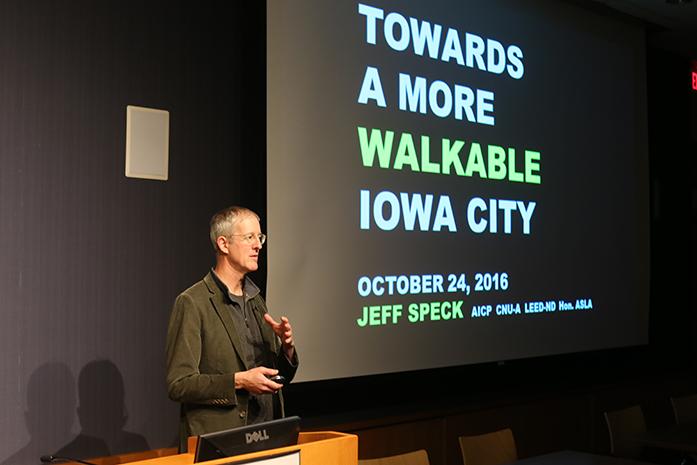Jeff Speck, a city planner and urban designer, discussed the issue of walkability in Iowa City at the Iowa City Public Library.
By Naomi Hofferber
Despite Iowa City being widely accessible to pedestrians, city officials continue to look into ways to improve walkability.
Jeff Speck, the author of Walkable City, addressed a full meeting room Monday night at the Iowa City Public Library. Several city councilors were in attendance, including Mayor Jim Throgmorton, and City Manager Geoff Fruin also attended.
Speck discussed reasons for walkability and ways a city can become more walkable, and he said there must be a reason to walk, safety while walking, a sense of comfortability when walking, and walking must be interesting.
“My argument for the walkable city is now no longer a planner’s argument, it’s the economist’s argument, the environmentalist’s argument, and the epidemiologist’s argument,” Speck said. “People want to be in walkable places now and are paying more to live there.”
A walkable city has most of the daily needs of an individual residing in the city, Speck said, including a place to live, a place to work, a place to shop, a place for recreation, and a place for worship. When things are within walking distance, the need for other forms of transportation is cut down, which is both economically and environmentally beneficial.
Speck also addressed the issue of urban sprawl with walkability, and how suburbs and cul-de-sacs are not conducive to that and lead to the need for mass infrastructure.
“For some, [living in suburbs] is the American dream, although the number of people who say they want to live in a house where they can’t walk to stores and restaurants and other things is about 10 percent,” Speck said. “This is the vision for many in the American Dream, but it’s a two-part deal.”
In order to allow for walkability, there must be an increase in housing in cities so the ratio of jobs to housing allows for individuals to live within walking distance of their jobs.
“My main frustration being here is that you are doing too well,” Speck joked. “Your city planning department and other departments are already on the right page. If anything perhaps I can light a fire under some of these things.”
Fruin said the city has plans to increase walkability by adjusting certain streets from four lanes into three —one each direction and a shared turn lane — a concept Speck brought up in order to increase safety in walkability.
“Over the last several years, we’ve developed a number of plans that align well with what Jeff spoke to,” he said. “The presentation really reinforces the direction we are trying to go.”
Speck also noted the implementation of public-art projects to cover blank walls, which makes walking more interesting and enjoyable. Iowa City has had several art projects in the city to cover blank areas, and Fruin said he would expect the continuation of that.
“In general, we want to produce a more walkable city,” Throgmorton said. “We are also seeking gold bike-friendly status, which means we will make an infrastructure investment, and painting and restriping and various things like that to create bike lines and make it easier to bike around the city in a safe and convenient way.”
Iowa City currently holds a silver status as a bike-friendly city, a ranking given by the League of American Bicyclists.
In addition to the street lane changes, Throgmorton said the council would like to implement a form-based code for the certain areas of Iowa City and create missing middle housing — which entails duplexes, townhouses, and small apartment complexes — in the city.
“The City Council, when it developed its strategic plan, specifically called on walkability and the need to continue to build on it,” Fruin said. “In Iowa City, I think it’s a strength of ours, but we need to capitalize on that even more, and push for even more walkable streets.”



